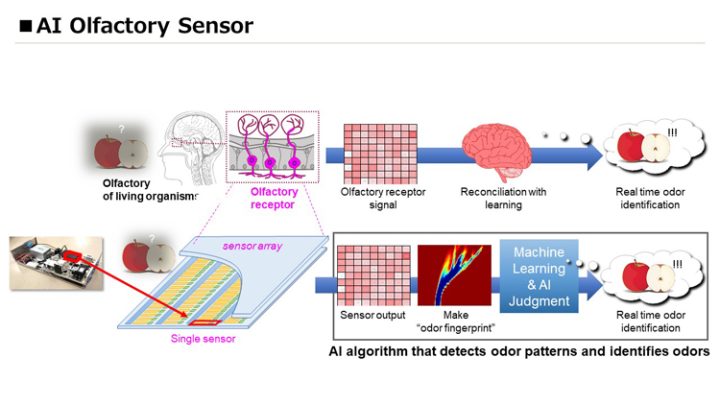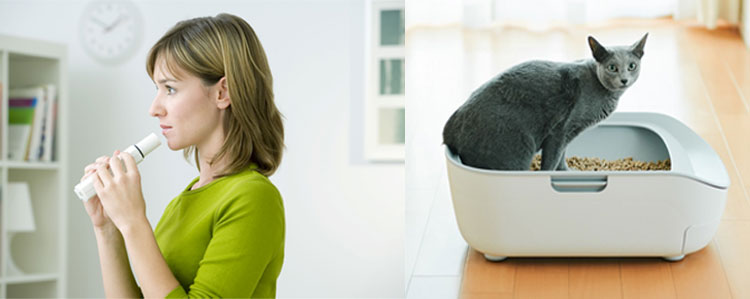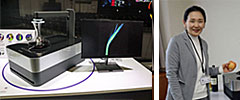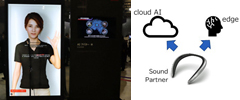Detecting Wine Brands by Aromas! AI Olfactory Sensor Development①
January 26, 2024

I once watched a TV series featuring a character with the uncanny ability to see smells. Unfortunately, in reality, people cannot see smells. However, if there were a device capable of visualizing smells, it would undoubtedly be invaluable to the world.
In fact, Sharp has developed a groundbreaking product that converts smells into images and identifying them! This innovative product is called “AI Olfactory Sensor”, and it achieves high accuracy at a low cost by utilizing AI (Artificial Intelligence) and Sharp’s specialized display substrate technology. The AI Olfactory Sensor made its debut at SHARP Tech-Day, Sharp’s inaugural independent technology exhibition held in Tokyo last November. It also garnered significant attention at CES 2024, one of the world’s largest technology trade shows held annually in Las Vegas at the beginning of the year.
In this two-part series, we interview Ms. Teranishi, who oversees the development of the AI Olfactory Sensor. Throughout our discussion, we explored into various aspects including its development process, features, advantages, future plans, and measurement principles.

– What inspired you to develop the AI Olfactory Sensor?
Sharp is a company renowned for its expertise in displays and possessing many related elemental technologies. Initially, I have been involved in the development of displays, and that is when I was asked for ideas to apply Sharp’s elemental technologies in fields other than displays. After research, I discovered that while image recognition sensors that act as the human eye are common, not many teams have developed olfactory sensors, which works as the nose. After exploring this concept further, I had a hunch that a low-cost, high-precision olfactory sensor could be achieved by repurposing display substrate technology and integrating AI. This realization propelled us into full-scale development around 2020.
– What is AI Olfactory Sensor?
The AI Olfactory Sensor is an innovative technology designed to replicate the olfactory sense of living organisms. It operates by capturing odors, which are subsequently converted into an image. Using AI algorithms, data is analyzed to determine the odor. Through the successful integration of AI with Sharp’s display substrate technology, we have achieved an Olfactory sensor that offers both low cost and high accuracy in judgment. One possible application is to facilitate quality control by visualizing the smell of products such as wine, perfume, etc., which have often relied on the five senses (particularly the sense of smell).


– What specific use cases are you considering for it?
Since odors can be quantitatively measured based on data, the system is expected to be deployed across a range of odor-related contexts. For fruits and vegetables, it is capable of assessing the degree of maturity and sugar content, while for fish, it enables the evaluation of product freshness without damaging the food.
At SHARP Tech-day, we conducted a demonstration to judge the branding of wines by having attendees to randomly select wine from six available options. In relation to alcoholic beverages, we are currently collaborating with a Japanese Sake brewer to jointly develop a quality control system for Japanese Sake. According to the sake brewer, 70 to 80% of the taste of sake is determined by its aroma, making it a crucial factor. However, the assessment of sake readiness for the market (outgoing shipment inspection) based on its aroma is still conducted by people, requiring both time and skill. The human judgment in this process is also influenced by the individual’s state of health at the time of the inspection. The AI Olfactory Sensor compensates for this part of the process, helping to quantify and improve the efficiency of quality control. In one shipment evaluation, the AI Olfactory Sensor achieved an average accuracy rate of 95.2% compared to the judgment of a shipment evaluation specialist.

– I see, it looks like it can help quality control of food and ingredients.
That’s not all. We believe it can also contribute to safeguarding the health of both people and pets. We are collaborating with Nara Medical University on a technology that can determine the state of health based on human metabolic odors. According to what we have heard, individuals with periodontal disease exhibits a distinct odor component in their breath. Periodontal disease, stemming from oral bacteria, can lead to infections in individuals undergoing surgeries, prompting the need for oral care provided prior to the surgery as a preventive measure. Given these insights, we were consulted on the possibility of creating a device that would encourage dental treatment based on halitosis detection, leading us to initiate joint research efforts.
We are considering this not only for people but also for pets. We are exploring the potential of assessing the health status of cats through the odor of their urine to explore possibilities for preventive measures.

Other possible applications would include sensors for detecting hazardous substances in factories, etc.
– The potential for odor-based solutions seems great. Please tell us about the principle of measurement in the next issue.
The AI Olfactory Sensor is not confined solely to wine evaluations; its applications span across diverse fields. We have learned that its potential in various areas beyond assessing wine. In our next issue, we will ask about the measurement principle of the AI Olfactory Sensor and what kind of display technology it utilizes.
<To be continued in the next issue>
(Public Relations H)
<Related Sites>
■Press Release:
Sharp to Take Part in CES 2024, Major US Tech Event
Sharp to hold SHARP Tech-Day from November 10 to 12
■SHARP Blog






